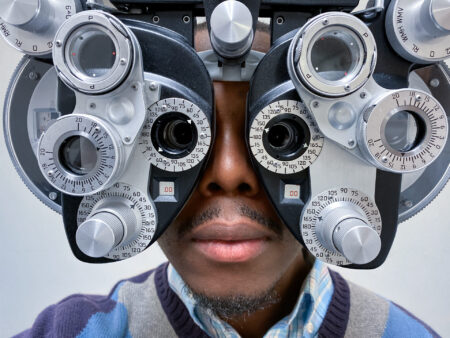Glaucoma is caused when your eyes can’t maintain an appropriate balance between the amount of internal fluid produced by the eye and the amount of fluid that drains away. Think of your eye as a football: It requires air pressure to maintain its shape and to maintain its round shape and ability to see. But a malfunction of internal eye structures that regulate intraocular pressure can cause pressure in the eye to rise extremely high, causing glaucoma.
Unlike a football, however, pressure in your eye can’t be relieved by deflating. Instead, high eye pressures keep building until optic nerve fibers are permanently damaged and peripheral vision is lost.
There are several types of glaucoma:
- Chronic open angle: This is caused by a gradual blockage of the drainage channel in your eye. Pressure builds slowly, leading to a gradual loss of side vision. This type of glaucoma progresses very slowly and is a lifelong condition.
- Acute closed angle: This type is caused by blockage of the drainage channel in your eye. Pressure increases suddenly, leading to nausea, blurred vision, severe pain and halos around lights. This type of glaucoma is a medical emergency; without immediate attention, permanent blindness occurs rapidly.
- Secondary: This type is caused by scar tissue from injury, infection, tumors, drugs or inflammation that blocks the drainage channel in your eye. As in chronic open angle glaucoma, this for progresses slowly, with the pressure causing a gradual loss of side vision.
- Congential: In this type of glaucoma, the eye fluid drainage system is abnormal at birth. Symptoms include enlarged eyes, cloudy corneas, sensitivity to light and excessive tearing. It must be treated soon after birth to save vision.
Worldwide, glaucoma affects more than 70 million people between the ages of 40 and 80. Risk factors associated with glaucoma include elevated intra-ocular pressure, age, family history, gender, ethnicity, central corneal thickness and impaired distant vision. That number is projected to jump to more than 111 million by 2040 due to the aging population.
Though every race can develop glaucoma, a study from Eye Disease Prevalence Research Group showed that, in the United States, African Americans have a higher likelihood than their white counterparts of getting it. We are also more likely to be diagnosed with glaucoma at a younger age than people of other races. And men are more likely to have glaucoma than women.
The reasons for our increased risk aren’t clear. One study found a prevalence of 7 percent in people of African descent, suggesting an ancestral connection. Other possible causes include physiological or anatomical differences in our corneas, environmental factors, social differences and genetics. Some studies suggest people with diabetes may be at higher risk of developing diabetes (the rate of diabetes in the Black community is at epidemic proportions), but this research isn’t definitive.
If you’re worried about getting glaucoma, talk to your doctor about these concerns:
- Family history. Your risk of developing glaucoma may be three to four times higher if one or more of your parents or siblings have the disease.
- Lifestyle. A sedentary lifestyle without regular exercise could increase your risk for glaucoma, according to one study. Smoking, alcohol intake and obesity also are potential lifestyle-related risk factors.
- Age. Your risk for developing glaucoma increases significantly after age 40 and continues to increase with each additional decade. This is partly because aging can cause drainage channels in your eye to shrink, which slows the outflow of fluid from the eye.
- Certain medical problems. Diabetes, extreme nearsightedness and previous eye surgery are risk factors for chronic glaucoma. If you have a condition that requires the use of oral or inhaled steroids for asthma, particularly if high doses are needed for prolonged periods, this can increase your risk, too. Other medical conditions that may increase your risk for glaucoma include migraine headaches, low blood pressure, narrowed blood vessels, cardiovascular disease and low cerebrospinal fluid pressure.
- Eye abnormalities. Certain abnormalities affecting internal eye structures can cause glaucoma. Pseudoexfoliation syndrome causes proteins in the eye’s natural lens, iris and other structures to slough off and clog the eye’s drainage system. Glaucoma also can result when a misshapen iris blocks the filtration angle where drainage occurs.
Research shows early treatment of glaucoma can cut the risk of worsening disease in half. And since glaucoma usually causes no symptoms, while at the same time stealing your sight, this is even more reason to have your eyes checked regularly. There is no cure for glaucoma and damage can’t be reversed, but treatment and regular eye exams can slow or prevent vision loss. Treatment options may include prescription eyedrops, oral medications, laser treatment, surgery or a combination of these.
Some lifestyle and home remedies may help you control high eye pressure or promote eye health:
- Eat a healthy diet. Your diet won’t prevent glaucoma from worsening, but it can help you maintain your health. Several vitamins and nutrients are important to eye health, including zinc, copper, selenium, and antioxidant vitamins A, C and E.
- Exercise safely. Regular exercise may reduce eye pressure in open-angle glaucoma. Talk to your doctor about an appropriate exercise regimen.
- Limit your caffeine. Beverages with large amounts of caffeine may increase eye pressure.
- Sip fluids frequently. Drink only moderate amounts of fluids at any given time during the course of a day. Drinking a quart or more of any liquid within a short time may temporarily increase eye pressure.
- Sleep with your head elevated. Using a wedge pillow that keeps your head slightly raised, about 20 degrees, has been shown to reduce intraocular pressure while you sleep.
- Take prescribed medicine. Using your eyedrops or other medications as prescribed can help you get the best possible result from your treatment. Use drops exactly as prescribed or your optic nerve damage could worsen.
—Kevin Pruitt, M.D.






